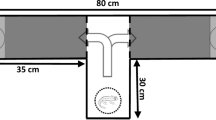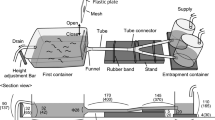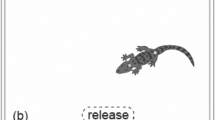Abstract
In this study, we tested the tendency of young cichlids to orient towards their parents using chemical cues. Convict cichlids have biparental defence of their free-swimming young. If young become separated from their family they must rejoin their family within minutes to have any chance of survival. Here, we used a dichotomous Y-maze to test if displaced convict cichlid young can use chemical cues to orient to their family. First, we showed that young preferentially orient toward water taken from their home tank versus blank water taken from a tank that contained no fish. Second, we showed that young prefer home tank water to water from a tank containing another family of convict cichlids. In a third experiment, we placed young convict cichlids in a small aquarium inserted within a larger aquarium. The large aquarium contained either their parents or no fish. The small insert aquarium contained blank water from a tank that had never contained fish. After 20 min in the insert tank, young convict cichlids were placed in the Y-maze and given a choice between either their home tank water or water from the insert tank. Convict cichlids that did not see their parents during the 20-min conditioning period oriented strongly toward chemical cues of their home tank water. Young that saw their parents during the 20-min conditioning period oriented strongly toward the chemical cues of the insert tank. These data indicate that young convict cichlids use visual cues to learn and reset the smell of “home” in less than 20 min.



Similar content being viewed by others
References
Alemadi SD, Wisenden BD (2002) Antipredator response to injury-released chemical alarm cues by convict cichlid young before and after independence from parental care. Behaviour 139:603–611
Alonzo JJ, McKaye KR, van den Berghe EP (2001) Parental defense of young by the convict cichlid, Archocentrus nigrofasciatus, in Lake Xiloá, Nicaragua. J Aquaric Aq Sci 9:208–227
Balon EK (1999) Alternative ways to become a juvenile or a definitive phenotype (and on some persisting linguistic offenses). Environ Biol Fish 56:17–38
Barnett C (1977) Chemical recognition of the mother by the young of the cichlid fish, Cichlasoma citrinellum. J Chem Ecol 3:461–466
Brown GE (2003) Learning about danger: chemical alarm cues and local risk assessment in prey fishes. Fish Fish 4:227–234
Bussing WA (1987) Peces de las agues continentals de Costa Rica. Editorial de la Universidad de Costa Rica, San Jose, Costa Rica
Chivers DP, Smith RJF (1994) Fathead minnows, Pimephales promelas, acquire predator recognition when alarm substance is associated with the sight of unfamiliar fish. Anim Behav 48:597–605
Chivers DP, Smith RJF (1995) Fathead minnows (Pimephales promelas) learn to recognize chemical stimuli from high-risk habitats by the presence of alarm substance. Behav Ecol 6:155–158
Clutton-Brock TH (1991) The Evolution of Parental Care. Princeton University Press, New Jersey
Cooper JC, Schalz AT, Horrall RM, Hasler AD, Madison DM (1976) Experimental confirmation of the olfactory hypothesis with homing artificially imprinted coho salmon (Onchorhynchus kisutch). J Fish Res Bd Can 33:703–710
De Gannes GC, Keenleyside MHA (1992) Convict cichlid fry prefer the more maternally active of two parental females. Anim Behav 44:525–531
Foam PE, Mirza RS, Chivers DP, Brown GE (2005) Juvenile convict cichlids (Archocentrus nigrofasciatus) allocate foraging and antipredator behaviour in response to temporal variation in predation risk. Behaviour 142:129–144
Hay TF (1978) Filial imprinting in the convict cichlid fish Cichlasoma nigrofasciatum. Behaviour 65:138–160
Honeycutt H, Alberts JR (2005) Housing pregnant mice (Mus musculus) in small groups facilitates the development of odor-based homing in offspring. J Comp Psychol 119:418–429
Keenleyside MHA (1991) Parental care. In Keenleyside, MHA ed. Cichlid Fishes: Behaviour, Ecology and Evolution. Chapman and Hall, New York, pp 191–208
Lavery RL, Mackereth RW, Robilliard DRC, Keenleyside MHA (1990) Factors determining parental preference of convict cichlid fry, Cichlasoma nigrofasciatum (Pisces: Cichlidae). Anim Behav 39:573–581
Magurran AE (1989) Acquired recognition of predator odour in the European minnow (Phoxinus phoxinus). Ethology 82:216–223
McKaye KR (1977) Competition for breeding sites between the cichlid fishes of Lake Jiloá, Nicaragua. Ecology 58:291–302
McKaye KR, Barlow GW (1976) Chemical recognition of young by the midas cichlid, Cichlasoma citrinellum. Copeia 1976:276–282
McKaye KR, McKaye NM (1977) Communal care and kidnapping of young by parental cichlids. Evolution 31:674–681
Meral GH (1973) The adaptive significance of territoriality in the New World Cichlidae. Ph.D. dissertation, University of California, Berkeley
Morse DH (1991) Homing by crab spiders Misumena vata (Aranea. Thomisidae) separated from their nests. J Arachnol 19:111–114
Myrberg AA (1966) Parental recognition of young in cichlid fishes. Anim Behav 14:565–571
Pollock MS, Zhao X, Brown GE, Kusch RC, Pollock RJ, Chivers DP (2005) The response of convict cichlids to chemical cues: an integrated study of behaviour, growth and reproduction. Ann Zool Fennici 42:485–495
Reebs SG, Colgan PW (1991) Nocturnal care of eggs and circadian rhythms of fanning activity in two normally diurnal cichlid fishes, Cichlasoma nigrofasciatum and Herotilapia multispinosa. Anim Behav 41:303–311
Reebs SG, Colgan PW (1992) Proximal cues for nocturnal egg care in convict cichlids, Cichlasoma nigrofasciatum. Anim Behav 43:209–214
Schaal B (1988) Olfaction in infants and children: developmental and functional perspectives. Chem Sen 13:145–190
Schmitter-Soto J (2007) Phylogeny of species formerly assigned to the genus Archocentrus (Perciformes: Cichlidae). Zootaxa 1618:1–50
Sheenan MGC, Waas JR, Lavery RJ (1994) The warning signals of parental convict cichlids are socially facilitated. Anim Behav 47:974–976
Siegel S, Castellan NJ Jr (1988) Nonparametric statistics for the behavioural sciences. McGraw-Hill, New York
Ward AJW, Axford S, Krause J (2002) Mixed-species shoaling in fish: the sensory mechanisms and costs of shoal choice. Behav Ecol Sociobiol 52:182–187
Ward AJW, Hart PJB, Krause J (2004) The effects of habitat- and diet-based cues on association preferences in three-spined sticklebacks. Behav Ecol 15:925–929
Ward AJW, Holbrook RI, Krause J, Hart PJB (2005) Social recognition in sticklebacks: the role of direct experience and habitat cues. Behav Ecol Sociobiol 57:575–583
Webster MM, Goldsmith J, Ward AJW (2007) Habitat-specific chemical cues influence association preferences and shoal cohesion in fish. Behav Ecol Sociobiol 62:273–280
Wisenden BD (1994a) Factors affecting reproductive success in free-ranging convict cichlids (Cichlasoma nigrofasciatum). Can J Zool 72:2177–2185
Wisenden BD (1994b) Factors affecting mate desertion by males in free-ranging convict cichlids (Cichlasoma nigrofasciatum). Behav Ecol 5:439–447
Wisenden BD (1995) Reproductive behaviour in free-ranging convict cichlids, Cichlasoma nigrofasciatum. Environ Biol Fish 43:121–134
Wisenden BD (2001) Brood defense and optimal brood size in convict cichlids Cichlasoma (Archocentrus nigrofasciatus), a species with biparental care. J Aquaric Aq Sci 9:303–320
Wisenden BD, Keenleyside MHA (1992) Intraspecific brood adoption in convict cichlids: a mutual benefit. Behav Ecol Sociobiol 31:263–269
Wisenden BD, Keenleyside MHA (1994) The dilution effect and differential predation following brood adoption in free-ranging convict cichlids (Cichlasoma nigrofasciatum). Ethology 96:203–212
Wisenden BD, Sargent RC (1997) Antipredator behavior and suppressed aggression by convict cichlids in response to injury-released chemical cues of conspecifics but not to those of an allopatric heterospecific. Ethology 103:283–291
Wisenden BD, Pogatshnik J, Gibson D, Bonacci K, Schumacher A, Willett A (2008a) Sound the alarm: learned association of predation risk with novel auditory stimuli by fathead minnows (Pimephales promelas) and glowlight tetras (Hemigrammus erythrozonus) after single simultaneous pairings with conspecific chemical alarm cues. Environ Biol Fish 81:141–147
Wisenden BD, Snekser JL, Stumbo AD, Leese JM (2008b) Post-predation parental care: defense of an empty nest after catastrophic brood loss. Anim Behav (in press)
Acknowledgements
We thank the MSUM College of Social and Natural Sciences for Faculty Research Grants to BDW. All work reported here complies with the Institutional Animal Care and Use Committee of Minnesota State University Moorhead, in the approved protocol number 02-T-BIOL-015NR1.
Author information
Authors and Affiliations
Corresponding author
Additional information
Communicated by J. Krause
Rights and permissions
About this article
Cite this article
Wisenden, B.D., Dye, T.P. Young convict cichlids use visual information to update olfactory homing cues. Behav Ecol Sociobiol 63, 443–449 (2009). https://doi.org/10.1007/s00265-008-0678-1
Received:
Revised:
Accepted:
Published:
Issue Date:
DOI: https://doi.org/10.1007/s00265-008-0678-1




